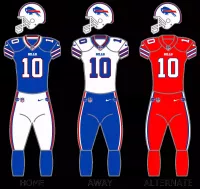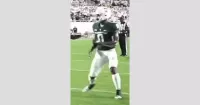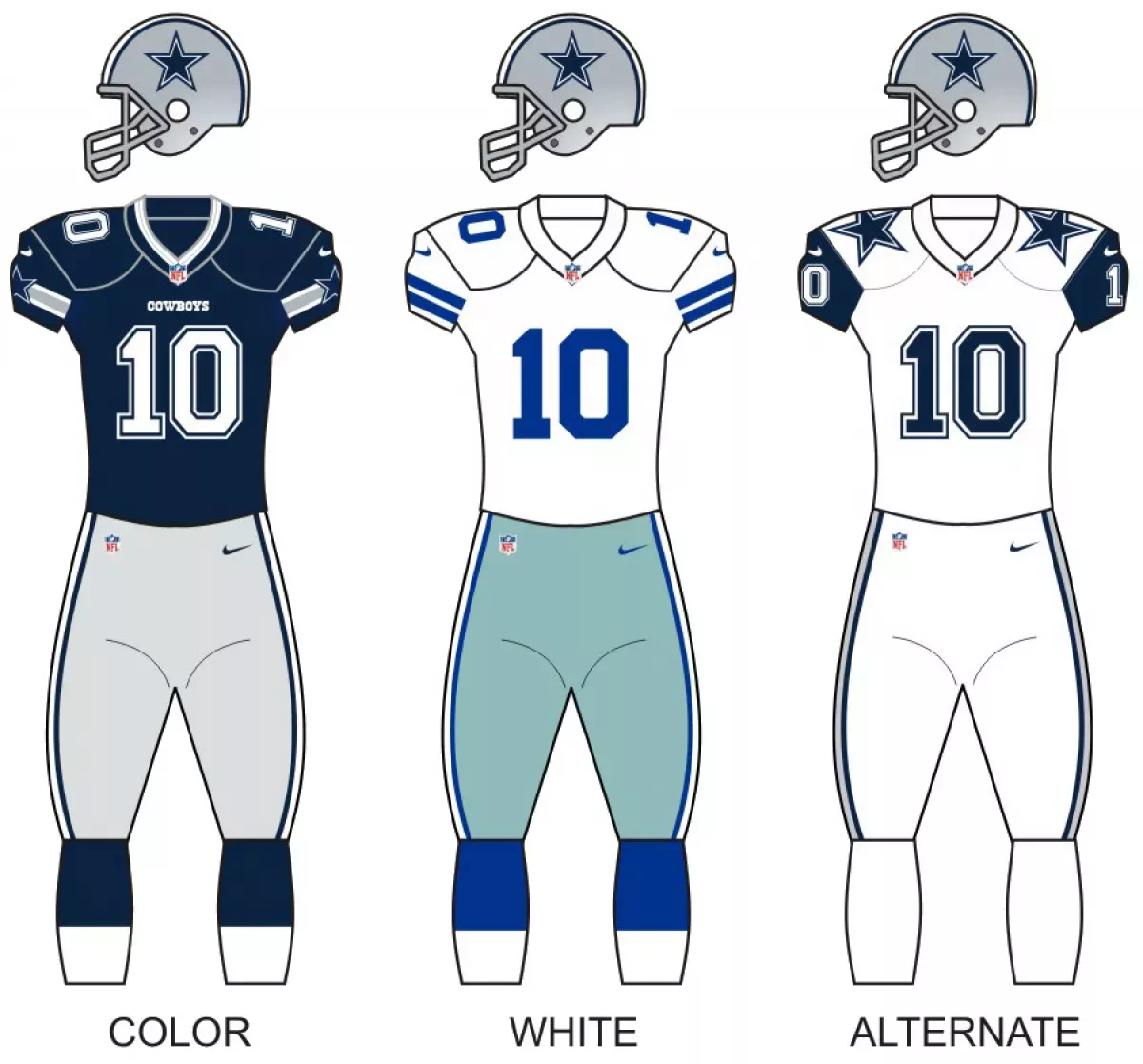The Dallas Cowboys are a professional American football team competing in the NFL as part of the NFC East division. They are based in the Dallas–Fort Worth metroplex, with headquarters in Frisco, Texas. Since 2009, the Cowboys have played their home games at AT&T Stadium in Arlington, Texas. The stadium's name reflects a naming rights agreement with AT&T.
1932: Opening of the Cotton Bowl
In 1932, the Cotton Bowl stadium opened and became known as "The House That Doak Built."
1934: Detroit Lions Host Thanksgiving Game
In 1934, the Detroit Lions popularized the tradition of hosting a Thanksgiving game, a tradition which influenced the Cowboys' decision to host their own game in 1966.
1952: Dallas Texans Fold
In 1952, the Dallas Texans folded, leaving no NFL team south of Washington, D.C.
1958: Murchison Tries to Buy Redskins
In 1958, Clint Murchison Jr. attempted to purchase the Washington Redskins (now Commanders) with the intention of moving them to Dallas, but the deal fell through due to a change in terms by owner George Preston Marshall.
1959: Murchison Sells Song Rights for Franchise Vote
Before the vote to award franchises in 1959, Murchison revealed to Marshall that he owned the song, and barred Marshall from playing it during games. Murchison then sold the rights to "Hail to the Redskins" back to Marshall in exchange for his vote, and a rivalry was born. The team also hired Tex Schramm, Gil Brandt, and Tom Landry to lead football operations.
1959: Murchison Buys "Hail to the Redskins"
In 1959, Murchison purchased the rights to the Washington Redskins fight song "Hail to the Redskins" from Barnee Breeskin for $2,500.
December 4, 1960: First Game: Giants vs Cowboys
On December 4, 1960, the first game ever played between the New York Giants and the Dallas Cowboys resulted in a 31–31 tie.
1960: Cowboys call the Cotton Bowl home
From 1960 to 1971, the Dallas Cowboys called the Cotton Bowl home for 11 years.
1960: Dallas Cowboys Franchise Debut Uniform
In 1960, the Dallas Cowboys franchise debuted with a white helmet adorned with a simple blue star and a blue-white-blue stripe, blue jerseys with white sleeves for home games, and the opposite for away games.
1960: First Game: Steelers vs Cowboys
In 1960, the Dallas Cowboys played in their first regular-season game, which was a 35–28 loss to the Pittsburgh Steelers.
1960: Throwback to 1960-1963 Road Jersey
In 1994, as part of a league-wide throwback policy, the Cowboys wore their 1960-1963 road jersey with a silver helmet for one game.
1960: 1960-1963 Uniform Resurrected
In 2004, the Cowboys resurrected their original 1960–1963 uniform on Thanksgiving Day, making it the team's alternate or "third jersey."
1960: Original jersey colors 1960
The Dallas Cowboys' original royal color jersey was first worn in 1960 and navy blue was used for the 2004 version.
October 29, 1961: Cowboys First Win Against Giants
On October 29, 1961, the Dallas Cowboys logged its first win in the series against the New York Giants.
1961: First Victory for Cowboys
In 1961, the Dallas Cowboys achieved their first-ever regular-season victory.
November 11, 1962: Giants First Win Against Cowboys
On November 11, 1962, the New York Giants achieved their first win against the Dallas Cowboys.
1963: 1960-1963 Uniform Resurrected
In 2004, the Cowboys resurrected their original 1960–1963 uniform on Thanksgiving Day, making it the team's alternate or "third jersey."
1963: Original jersey colors 1963
The Dallas Cowboys' original royal color jersey was worn until 1963 and navy blue was used for the 2004 version.
1964: Tradition of Wearing White Jerseys at Home Started
In 1964, Tex Schramm started the tradition of the Cowboys wearing their white jersey at home so fans could see a variety of opponents' colors.
1964: Cowboys Opt for Simpler Uniform Look
In 1964, the Cowboys opted for a simpler look, changing their jersey/socks to one solid color with three horizontal stripes on the sleeves. The helmet was silver-blue, with a blue-white-blue tri-stripe and a white-bordered blue "lone star" logo.
1964: White home uniform tradition begins
In 1964, the Dallas Cowboys started the tradition of wearing white uniforms for home games.
1966: Cowboys Host Second NFL Thanksgiving Game
In 1966, the Dallas Cowboys agreed to host a second NFL Thanksgiving game, defeating the Cleveland Browns 26–14.
1966: Start of 20 Straight Winning Seasons
In 1966, the Dallas Cowboys began a record of 20 straight winning seasons.
1966: Cowboys host NFL Championship at the Cotton Bowl
In 1966, the Dallas Cowboys hosted the Green Bay Packers for the NFL Championship at the Cotton Bowl.
1966: Modification of Cowboys Jerseys
In 1966, the Dallas Cowboys modified the jerseys to feature only two sleeve stripes, slightly wider; the socks followed the same pattern.
1967: Mercer Calls Ice Bowl
In 1967, Bill Mercer called the Ice Bowl.
1967: Addition of Blue Outline to Helmet Logo
In 1967, the "lone star" helmet decal added a blue outline to the white-bordered star, giving the logo a bigger, bolder look.
1967: Eastern Conference Title and Ice Bowl Loss
In 1967, the Dallas Cowboys won their second consecutive Eastern Conference title but lost the NFL Championship Game (Ice Bowl) to the Green Bay Packers.
1968: Dallas wears blue in one regular season game
In 1968, the Dallas Cowboys wore their blue uniforms in one regular season game.
1968: "Jinxed" Blue Jersey Controversy
The roots of the "jinxed" blue jersey curse likely date back to the 1968 divisional playoffs, when the blue-shirted Cowboys were upset by the Cleveland Browns.
1970: Regular Season Games
From 1970 through 1979, the Cowboys won 105 regular season games, more than any other NFL franchise during that time span.
1970: NFL-AFL merger
In 1970, after the NFL-AFL merger, league rules were changed to allow the Super Bowl home team to choose their jersey.
1970: Super Bowl V Loss
In 1970, led by quarterback Craig Morton, the Cowboys had a 10–4 season, won the NFC Championship, and qualified for Super Bowl V, where they lost 16–13 to the Baltimore Colts. Chuck Howley was named Super Bowl MVP despite the loss.
1970: Cowboys Defeat 49ers in NFC Championship
In 1970, the Dallas Cowboys defeated the San Francisco 49ers in the NFC Championship game.
1970: Minor Changes to Cowboys Uniform
In 1970, there were a few notable changes to the Dallas Cowboys uniform.
October 24, 1971: Opening of Texas Stadium
Texas Stadium opened on October 24, 1971, at a cost of $35 million and with a seating capacity of 65,675.
1971: Move to Texas Stadium and Super Bowl VI Win
In 1971, the Cowboys moved to Texas Stadium and won Super Bowl VI, defeating the Miami Dolphins 24–3. Roger Staubach was named Super Bowl MVP.
1971: Cowboys Defeat 49ers in NFC Championship
In 1971, the Dallas Cowboys defeated the San Francisco 49ers in the NFC Championship game.
1972: Cowboys Defeat 49ers in Divisional Playoff Game
In 1972, the Dallas Cowboys defeated the San Francisco 49ers in the Divisional Playoff Game.
1972: Dallas does not wear blue in regular season
The 1972 season was the only season since 1964 in which the Dallas Cowboys did not wear their blue uniforms in a regular season game, although they wore them three times in the preseason.
1974: Missed Playoffs
After missing the playoffs in 1974, the team drafted Randy White and Thomas "Hollywood" Henderson the following year.
1975: Bob Lilly Inducted to Ring of Honor
In 1975, Bob Lilly was the first inductee into the Dallas Cowboys' "Ring of Honor".
1975: Super Bowl X Loss
In 1975, after drafting Randy White and Thomas "Hollywood" Henderson, the Cowboys made it back to the playoffs as a wild card, losing to the Pittsburgh Steelers, 21–17, in Super Bowl X.
1975: Hail Mary Pass
In 1975, the Dallas Cowboys and Minnesota Vikings game featured the famous Hail Mary pass.
1975: Cowboys Win NFC Championship
In 1975, the Dallas Cowboys won the NFC championship on the road against the Los Angeles Rams.
1975: Dallas wears blue in one regular season game
In 1975, the Dallas Cowboys wore their blue uniforms in one regular season game.
1975: St. Louis Cardinals Replace Dallas as Thanksgiving Host
In 1975, the St. Louis Cardinals replaced Dallas as a host team for Thanksgiving games at the behest of Commissioner Pete Rozelle.
1976: Helmet Stripe Changed for Bicentennial
During the 1976 season, the blue-white-blue stripe on the crown of the helmets was temporarily changed to red-white-blue to commemorate the United States' bicentennial anniversary.
1976: Dallas Hosts St. Louis Cardinals on Thanksgiving
In 1976, Dallas hosted St. Louis in an effort by the NFL to give St. Louis national exposure for Thanksgiving.
1976: "Jinxed" Blue Jersey Controversy
In 1976, a regular season road game against the St. Louis Cardinals added to the “jinxed” Blue Jersey controversy when the team elected to wear white as the home team and promptly defeated the then-undefeated Cowboys.
1976: Dallas wears blue in one regular season game
In 1976, the Dallas Cowboys wore their blue uniforms in one regular season game.
1977: Sham Joins Network
In 1977, Brad Sham joined the Dallas Cowboys Radio Network as the color analyst and occasional fill-in for Verne Lundquist.
1977: Super Bowl XII Win
In 1977, the Dallas Cowboys finished the season 12-2 and defeated the Denver Broncos 27-10 in Super Bowl XII, with Randy White and Harvey Martin named co-Super Bowl MVPs.
1977: Dallas wears blue in one regular season game
In 1977, the Dallas Cowboys wore their blue uniforms in one regular season game.
1977: St. Louis Cardinals Replace Dallas as Thanksgiving Host
In 1977, the St. Louis Cardinals replaced Dallas as a host team for Thanksgiving games at the behest of Commissioner Pete Rozelle.
1977: Franchise Record Broken in 2016
In 2016, the Cowboys won their 9th straight game, breaking a franchise record of 8 straight games set in 1977.
1978: Super Bowl Loss and "America's Team" Nickname
Following the 1978 season, the Dallas Cowboys lost to Pittsburgh 35-31 in the Super Bowl. Bob Ryan, an NFL Films editor, dubbed the Cowboys "America's Team" following the Super Bowl loss.
1978: Dallas Resumes Regular Hosting of Thanksgiving Games
In 1978, after Rozelle asked Dallas to resume hosting Thanksgiving games, the Cowboys requested (and received) an agreement guaranteeing the Cowboys a spot on Thanksgiving Day for good.
1978: Victory in NFC Championship Game
In 1978, the Dallas Cowboys won the NFC Championship Game against the Los Angeles Rams while wearing their blue uniforms.
1978: First Super Bowl berth since 1978
On January 17, 1993, the Cowboys clinched their first Super Bowl berth since 1978 by defeating the San Francisco 49ers.
1979: Regular Season Games
From 1970 through 1979, the Cowboys won 105 regular season games, more than any other NFL franchise during that time span.
1980: Danny White Becomes Starting Quarterback
In 1980, Danny White became the Cowboys' starting quarterback after Roger Staubach retired.
1980: Cowboys Win Wild Card Round
In 1980, the Dallas Cowboys won the Wild Card Round against the Los Angeles Rams.
1980: Eagles host Cowboys in NFC Championship Game
In the 1980 NFC Championship Game, the Philadelphia Eagles hosted the Dallas Cowboys and wore their white jerseys at home to invoke the curse.
January 1981: Eagles win NFC Championship against Cowboys
In January 1981, the Philadelphia Eagles defeated the Dallas Cowboys 20–7 in the NFC Championship game.
1981: The Catch
In 1981, during the NFC Championship Game in San Francisco, Joe Montana of the 49ers completed a game-winning pass to Dwight Clark in the final minute, a play now known as "The Catch".
1981: Division Championship and NFC Championship Loss
In 1981, the Cowboys won another division championship and reached the NFC Championship Game, where they lost to the San Francisco 49ers 28-27 due to "The Catch" by Dwight Clark.
1982: Playoff Appearance and NFC Championship Loss
During the strike-shortened 1982 season, the Dallas Cowboys made it to the playoffs for the 8th consecutive season but lost to the Washington Redskins in the NFC Championship Game.
1982: Washington Wins NFC Championship
In 1982, the Washington Commanders secured a victory over the Dallas Cowboys in the NFC Championship.
1982: First Playoff Win Since 1982
In 1991, the Cowboys defeated the Bears 17-13 in the Wild Card round, marking their first playoff win since 1982.
1983: Playoff Upset Loss to Rams
In 1983, the Dallas Cowboys went 12–4 and made it once again to the playoffs but were upset at home in the Wild Card by the Rams 24–17.
1984: Missed Playoffs
In 1984, the Dallas Cowboys missed the playoffs during their streak of 20 straight winning seasons.
1984: Murchison Sells the Cowboys
Prior to the 1984 season, Murchison sold the Cowboys to H.R. "Bum" Bright and his ten partners.
1985: Hansen Joins Broadcast Team
In 1985, Dale Hansen became the Dallas Cowboys color analyst alongside Brad Sham.
1985: End of 20 Straight Winning Seasons
In 1985, the Dallas Cowboys ended their record of 20 straight winning seasons.
1985: Division Title and Playoff Loss
In 1985, the Dallas Cowboys went 10-6, winning a division title, but were shut out by the Rams in the Divisional round.
1987: 7-8 Season
In 1987, the Dallas Cowboys had a 7-8 season, and owner Bum Bright criticized Tom Landry's play calling.
December 11, 1988: Landry's Last Game
On December 11, 1988, the last Dallas Cowboys game with Tom Landry as coach was a win over the Washington Commanders.
February 25, 1989: Jerry Jones Buys Team
On February 25, 1989, Jerry Jones bought the Dallas Cowboys from Bum Bright for $150 million.
1989: Landry Fired, Johnson Hired, Aikman Drafted
In 1989, Jerry Jones fired Tom Landry and hired Jimmy Johnson as head coach. The Cowboys drafted Troy Aikman first overall. They also traded Herschel Walker to the Vikings.
1989: Bounty Bowls
In 1989, tensions flared during the Bounty Bowls, where Philadelphia Eagles head coach Buddy Ryan allegedly placed a bounty on Dallas Cowboys kicker Luis Zendejas.
1989: Drafted Daryl Johnston and Mark Stepnoski
In 1989, the Cowboys drafted fullback Daryl Johnston and center Mark Stepnoski.
1989: Cowboys Win Against Washington
In 1989, the Dallas Cowboys achieved a win over the Washington Commanders, marking their only victory that season.
1990: First Home Game Win Since 1988
In 1990, the Cowboys won their first home game since September 1988, defeating the San Diego Chargers 17-14.
1991: Cowboys Consecutive Postseason Appearances
In 1991, the Cowboys began a run of six consecutive postseason appearances, continuing until 1996.
1991: Drafted Russell Maryland and Erik Williams
In 1991, the Cowboys drafted defensive tackle Russell Maryland and offensive tackle Erik Williams.
1991: Cowboys replaced offensive coordinator Dave Shula with Norv Turner
In 1991, the Cowboys replaced offensive coordinator Dave Shula with Norv Turner and raced to a 6-5 start. Despite an injury to Troy Aikman, they defeated the previously unbeaten Redskins, with backup Steve Beuerlein taking over. The Cowboys finished the season 11-5.
1992: Cowboys start winning streak against Eagles
From 1992–1995, the Dallas Cowboys won seven straight matches against Philadelphia.
1992: Team Record for Regular-Season Wins
In 1992, Dallas set a team record for regular-season wins with a 13-3 mark, starting the season by defeating the defending Super Bowl champion Redskins 23-10. They earned the number 2 seed and advanced to the NFC Conference Championship game after defeating the Philadelphia Eagles.
1992: Drafted Darren Woodson
In 1992, the Cowboys drafted safety Darren Woodson.
1992: Cowboys Super Bowl-Winning Season
In 1992, the Dallas Cowboys had their Super Bowl-winning season.
1992: Cowboys Win NFC Championship
In 1992, the Dallas Cowboys won the NFC Championship Game against the San Francisco 49ers.
January 17, 1993: Cowboys Clinch Super Bowl Berth
On January 17, 1993, the Cowboys defeated the San Francisco 49ers 30-20 at Candlestick Park to clinch their first Super Bowl berth since 1978.
1993: Tom Landry Accepts Ring of Honor Induction
In 1993, Tom Landry accepted induction into the Dallas Cowboys' "Ring of Honor", with a ceremony held on the day of that year's Cowboys-Giants game, partly due to Roger Staubach's efforts.
November 24, 1994: Unveiling of white "Double-Star" jersey
On November 24, 1994, the Dallas Cowboys unveiled their white "Double-Star" jersey for the first time during their Thanksgiving Day game.
1994: Cowboys finished 12-4
In 1994, the Cowboys finished with a 12-4 record and clinched a first-round bye. However, they lost to the San Francisco 49ers in the NFC Championship Game.
1994: NFL 75th Anniversary and "Double-Star" Jersey Unveiling
In 1994, the NFL celebrated their 75th Anniversary, and the Dallas Cowboys celebrated their back-to-back Super Bowl titles by unveiling a white "Double-Star" jersey on Thanksgiving Day. The Cowboys also wore their 1960–63 road jersey with a silver helmet for one game as part of a league-wide "throwback" policy.
1994: 49ers Win NFC Championship
In 1994, the San Francisco 49ers won the NFC Championship Game against the Dallas Cowboys.
1994: Double-Star jersey introduced
The 1994 "Double-Star" jersey was used as inspiration for the Cowboys color rush jersey in 2015.
1995: Navy "Double-Star" Jersey Introduction
During the 1995 season, the Dallas Cowboys wore the navy "Double-Star" jersey for games at Washington and Philadelphia and permanently switched to solid color socks.
1995: Cowboys continue winning streak against Eagles
From 1992–1995, the Dallas Cowboys won seven straight matches against Philadelphia.
1995: Garrett Becomes Play-by-Play Announcer
In 1995, Dave Garrett became the Dallas Cowboys' play-by-play announcer.
1995: Emmitt Smith set an NFL record with 25 rushing touchdowns
In 1995, the Cowboys started the season 4-0, and Emmitt Smith set an NFL record with 25 rushing touchdowns. They finished 12-4 and won Super Bowl XXX against the Pittsburgh Steelers.
January 1996: Cowboys Win Super Bowl XXX
In January 1996, the Dallas Cowboys won Super Bowl XXX against the Pittsburgh Steelers.
1996: Irvin suspended by the league for the first five games
In 1996, Star receiver Michael Irvin was suspended by the league for the first five games and The Cowboys finished the regular season with a 10-6 record. They were eliminated in the Divisional Round of the playoffs by the Carolina Panthers.
1996: Cowboys Consecutive Postseason Appearances End
In 1996, the Cowboys completed a run of six consecutive postseason appearances, beginning in 1991.
1996: First Cowboys post-season win since the 1996 season
In 2009, The Cowboys defeated the Eagles for the first Cowboys post-season win since the 1996 season
1997: Cowboys went 6-10 in 1997
In 1997, the Cowboys went 6-10, losing the last six consecutive games of the season, with discipline and off-field problems becoming major distractions.
January 1998: Switzer Resigned as Head Coach
Due to the Cowboys' poor performance and off-field issues, Switzer resigned as head coach in January 1998.
1998: Gailey led the team to two playoff appearances
In 1998, Chan Gailey led the Cowboys to a 10-6 record and an NFC East championship, marking their sixth in seven years. However, they were upset at home in the Wild Card Round by the Arizona Cardinals 20-7.
1998: Dallas wears blue in one regular season game
In 1998, the Dallas Cowboys wore their blue uniforms in one regular season game.
1998: Swept NFC East for the First Time Since 1998
In 2021, the Cowboys swept the NFC East for the first time since 1998.
1999: Eagles fans cheer Michael Irvin injury
During a 1999 game in Philadelphia, Eagles fans cheered as Michael Irvin lay motionless on the field at Veterans Stadium.
1999: Irvin Suffered a Career-Ending Injury
In 1999, Dallas went 8-8 in a season that featured Michael Irvin suffering a career-ending cervical spine injury. The season ended in a Wild Card playoff loss, and Chan Gailey was fired.
1999: Redskins division title since 1999
In 2012, the Washington Redskins were one win away from their first division title since 1999.
2000: Aikman suffered a serious concussion which ultimately ended his career.
In 2000, Troy Aikman suffered a serious concussion during the Week 1 game against the Philadelphia Eagles, which ultimately ended his career.
2001: Aikman retired due to concussions
In 2001, Troy Aikman was released from the Cowboys and retired due to the concussions he had received.
2001: Navy "Double-Star" Jersey Return on Thanksgiving
In 2001, the navy "Double-Star" jersey returned during the NFL's Classic Throwback Weekend on Thanksgiving Day.
2001: Cowboys home record in blue uniforms since 2001
Since 2001, the Dallas Cowboys have a 16–13 record at home while wearing the blue uniforms.
2002: First Season Since 2002 without Romo
2017 was the first season since 2002 without quarterback Tony Romo.
2002: Consecutive Sell-Out Streak Begins
In 2002, the Dallas Cowboys began a streak of 190 consecutive sold-out regular and post-season games, both at home and away, an NFL record.
2002: Emmitt Smith Broke All-Time NFL Rushing Record
The highlight of 2002 was on October 28, when Emmitt Smith broke Walter Payton's all-time NFL rushing record during a home game against the Seattle Seahawks. However, the Cowboys lost their next four games after that.
2003: Tex Schramm Inducted to Ring of Honor
In 2003, Tex Schramm was chosen by Jerry Jones for induction into the Dallas Cowboys' "Ring of Honor" and Schramm and Jones held a joint press conference at Texas Stadium announcing the induction.
2003: The Cowboys became the surprise team
In 2003, coached by Bill Parcells, the Cowboys became the surprise team of the season with a 7-2 start, finishing 10-6. They lost in the Wild Card round to the Carolina Panthers.
2003: Navy "Double-Star" Jersey Return on Thanksgiving
In 2003, the navy "Double-Star" jersey returned during the NFL's Classic Throwback Weekend on Thanksgiving Day.
2004: Dallas was unable to replicate their 2003 success
In 2004, Dallas was unable to replicate their 2003 success and ended with a 6-10 record. Quincy Carter was released and replaced by Vinny Testaverde at quarterback.
2004: Resurrection of Original Uniform
In 2004, the Cowboys resurrected their original 1960–1963 uniform on Thanksgiving Day, making it the team's alternate or "third jersey."
2004: Team dons blue throwback jerseys
In the 2004 season, the Dallas Cowboys chose to don blue jerseys worn in their first 4 years of existence, which included white helmets and pants.
September 19, 2005: The Triplets Inducted to Ring of Honor
On September 19, 2005, Troy Aikman, Emmitt Smith, and Michael Irvin, known as "The Triplets", were inducted into the Dallas Cowboys' "Ring of Honor" during halftime at a Monday Night Football home game against the Washington Redskins.
2005: Ring of Honor Composition
By 2005, the Dallas Cowboys' "Ring of Honor" contained 17 names, consisting of former Dallas players, one head coach, and one general manager/president.
2005: Throwback Uniform Worn During Ring of Honor Induction
In 2005, the Cowboys wore their original 1960–1963 uniform during the Monday Night game against the Washington Redskins, when Troy Aikman, Emmitt Smith, and Michael Irving were inducted into the Cowboys Ring of Honor.
2005: Cowboys got off to a great 7-3 start
The Dallas Cowboys got off to a great 7-3 start for the 2005 season but ended up in 3rd place with a 9-7 record. Prior to the beginning of that season, they signed veteran Drew Bledsoe as starting quarterback.
2006: Romo named as the starter
In 2006, Tony Romo replaced Drew Bledsoe as the starting quarterback during a game against the New York Giants. Romo went 5-1 in his first 6 games, and Dallas ended the season with a 9-7 record.
2006: Throwback Uniform Worn on Christmas Day
In 2006, the Cowboys wore their original 1960–1963 uniform on Christmas Day against the Philadelphia Eagles.
2006: Waters Joins Broadcast Team
In 2006, the Dallas Cowboys chose not to renew Babe Laufenberg's contract and brought in Charlie Waters to be the analyst on the radio broadcast.
2006: Cowboys Consecutive Postseason Qualification
In 2006, the Dallas Cowboys qualified for the postseason for the first time since 2006–2007.
2006: Roof of Texas Stadium repainted
In the summer of 2006, the roof of Texas Stadium was repainted by the City of Irving, marking the first time it had been repainted since the stadium opened.
November 4, 2007: Eagles host Cowboys wearing white jerseys
On November 4, 2007, the Philadelphia Eagles hosted the Dallas Cowboys wearing their white jerseys.
November 29, 2007: Cowboys Wear Throwback Uniform Against Packers
On November 29, 2007, the Dallas Cowboys wore their original 1960–1963 uniform against the Green Bay Packers.
2007: Cowboys use "throwback" uniform
Aside from the 2007 and 2008 seasons, the Cowboys continued to use their "throwback" uniform through Thanksgiving Day 2012.
2007: Laufenberg Returns
In 2007, Babe Laufenberg returned to the Dallas Cowboys broadcast team after a one-year absence, replacing Charlie Waters.
2007: Cowboys Consecutive Postseason Qualification
In 2007, the Dallas Cowboys qualified for the postseason for the first time since 2006–2007.
2007: Giants Defeat Cowboys in Playoffs
In 2007, the New York Giants defeated the Dallas Cowboys in the playoffs during their Super Bowl XLII-winning season.
2007: Cowboys clinched their first number 1 NFC seed in 12 years
The Dallas Cowboys started the 2007 season strong, winning their first five games and clinching their first number 1 NFC seed in 12 years with a 13-3 record. However, they lost in the divisional round to the eventual Super Bowl champion New York Giants.
November 23, 2008: Cowboys Wear Throwback Uniform Against 49ers
On November 23, 2008, the Dallas Cowboys wore their original 1960–1963 uniform against the San Francisco 49ers.
December 20, 2008: Cowboys lose final game at Texas Stadium
On December 20, 2008, the Dallas Cowboys lost their final game at Texas Stadium to the Baltimore Ravens, 33–24.
2008: Cowboys use "throwback" uniform
Aside from the 2007 and 2008 seasons, the Cowboys continued to use their "throwback" uniform through Thanksgiving Day 2012.
2008: Romo suffered a broken pinkie in an overtime loss
In 2008, Tony Romo suffered a broken pinkie during an overtime loss to the Arizona Cardinals. The Cowboys finished the season with a 9-7 record and failed to make the playoffs.
2008: Eagles defeat Cowboys 44-6
In 2008, in the last game of the year, the Philadelphia Eagles defeated the Dallas Cowboys 44–6, with both teams vying for a playoff spot.
2008: First Home Win Against Giants Since 2008
In 2013, the Cowboys defeated the New York Giants, marking their first home win against the Giants since 2008.
May 2, 2009: Dallas Cowboys' practice facility collapsed during a wind storm
On May 2, 2009, the Dallas Cowboys' practice facility collapsed during a wind storm, injuring twelve players and coaches. Special teams coach Joe DeCamillis and scouting assistant Rich Behm suffered serious injuries.
May 29, 2009: Completion of AT&T Stadium
On May 29, 2009, AT&T Stadium, previously named Cowboys Stadium, was completed in Arlington, Texas.
August 22, 2009: Screen repositioned at stadium
On August 22, 2009, the day after AJ Trapasso hit the screen, many fans touring the facility noted that half of the field was removed with large cranes re-positioning the screen. According to some fans, a tour guide explained that Jerry Jones invited a few professional soccer players to drop kick soccer balls to try to hit the screen. Once he observed them hitting it consistently he had the screen moved up another 10 feet.
September 28, 2009: Cowboys get first regular-season home win
On September 28, 2009, the Dallas Cowboys got their first regular-season home win at Cowboys Stadium, beating the Carolina Panthers 21–7 with 90,588 in attendance.
2009: AT&T Stadium opens with world's largest HDTV screen
In 2009, AT&T Stadium opened with a gigantic, center-hung high-definition television screen, which was at one point the largest in the world, measuring 160 by 72 feet.
2009: Favre's Last Playoff Win
In 2009, Brett Favre led the Minnesota Vikings to a playoff win against the Dallas Cowboys, which would be his last playoff win of his career.
2009: AT&T Stadium opens
In 2009, the Dallas Cowboys began playing their home games at AT&T Stadium in Arlington, Texas, following its opening.
2009: First Regular Season Game at Cowboys Stadium
In 2009, the New York Giants won the first regular-season game played at Cowboys Stadium.
2009: First Division Title Since 2009
In 2014, by defeating the Colts 42-7, Dallas was in a position to clinch their first division title since 2009.
2009: Miles Austin record-setting day
The 2009 season, receiver Miles Austin got his first start of the season and had a record-setting day with 250 yards receiving and 2 touchdowns.
January 2010: Cotton Bowl Classic moves to AT&T Stadium
Beginning with the January 2010 game, the Cotton Bowl Classic has been played at AT&T Stadium in Arlington.
April 11, 2010: Demolition of Texas Stadium
Texas Stadium was demolished by implosion on April 11, 2010.
2010: Jason Garrett was promoted to interim head coach
After beginning the 2010 season at 1-7, Wade Phillips was fired as head coach and was replaced by offensive coordinator Jason Garrett as the interim head coach.
2010: Jason Garrett becomes Cowboys Head Coach
In 2010, Jason Garrett became the Dallas Cowboys Head Coach, after previously being a 3rd string Quarterback, where he led a come-from-behind victory against the Green Bay Packers.
2010: Dallas wears blue in one regular season game
In 2010, the Dallas Cowboys wore their blue uniforms in one regular season game.
2010: Cowboys finished the season 6-10
In 2010, with Garrett as interim head coach, the Cowboys finished the season with a 6–10 record, a significant improvement after starting at 1–7.
2010: Romo injured same collarbone as 2010
In 2015, Romo suffered a broken left collarbone, the same one he injured in 2010, and Brandon Weeden replaced him.
February 2, 2011: Partnership with Compass Media Networks
On February 2, 2011, the Dallas Cowboys began a five-year partnership with Compass Media Networks to expand its radio broadcasting scope nationally, resulting in the America's Team Radio Network.
November 6, 2011: Haley, Allen, and Pearson Inducted to Ring of Honor
On November 6, 2011, Charles Haley, Larry Allen, and Drew Pearson were inducted into the Dallas Cowboys' "Ring of Honor" during halftime of the Cowboys' game vs. the Seattle Seahawks.
2011: Charlotte Motor Speedway announces larger HDTV screen
In 2011, Charlotte Motor Speedway unveiled its plans for a new HDTV screen larger than the one in AT&T Stadium.
2011: Cowboys Season
In 2011, the Cowboys played the New York Jets on September 11, losing due to late-game turnovers. Tony Romo suffered a rib injury in Week 2 against the 49ers but returned to lead a comeback win. The Cowboys finished the season 8-8, missing the playoffs after losing to the Giants in Week 17.
2011: Garrett signed as head coach
In 2011, the Cowboys signed Garrett as the head coach after his interim performance the previous year.
2012: Cowboys Season
In 2012, the Cowboys started by defeating the Super Bowl champion New York Giants. They hovered around .500 for most of the season, losing a close Week 6 game to the Baltimore Ravens. They lost to the Washington Redskins in Week 17 and finished the season 8-8.
2012: Washington Wins NFC East
In 2012, the Washington Commanders defeated the Dallas Cowboys 28–18 in week 17 to win the NFC East.
2012: Cowboys use "throwback" uniform through Thanksgiving Day
The Cowboys continued to use their "throwback" uniform through Thanksgiving Day 2012.
July 25, 2013: AT&T acquires naming rights to stadium
On July 25, 2013, the Dallas Cowboys announced that AT&T would be taking over the rights to the name of the stadium, renaming it AT&T Stadium.
2013: NFL announces "One-helmet" rule
Before the start of the 2013 season, the NFL announced a "One-helmet" rule to help prevent potential player concussions, which prevented the Dallas Cowboys from pairing the white helmets with the throwback uniforms.
2013: Cowboys vs Eagles
During the 2013 season, the Dallas Cowboys won the first meeting against the Philadelphia Eagles with a score of 17-3 at Lincoln Financial Field in Philadelphia. Later in Week 17, the teams met again at AT&T Stadium, with the Eagles winning 24-22 due to a late interception, clinching the 2013 NFC East title and ending the Cowboys' season.
2013: AT&T acquires naming rights for the stadium
In 2013, AT&T acquired the naming rights for the Cowboys' stadium, renaming it AT&T Stadium prior to the season.
2013: Cowboys Wear Blue Jerseys at Home for Thanksgiving
In 2013, during the "one-shell era", the Cowboys wore their normal blue jerseys at home for Thanksgiving.
2013: NFL Helmet Rule Change
In 2013, the NFL issued a new helmet rule stating that players would no longer be allowed to use alternate helmets, causing the Cowboys' white 1960s throwback helmets to become non-compliant.
2013: NFL helmet rule impacts alternate jerseys
With the implementation of the 2013 NFL helmet rule for alternate jerseys, the Dallas Cowboys decided to wear their regular blue jerseys for their Thanksgiving game, something they had not done at home since Schramm started the white-jersey-at-home tradition.
2014: Cowboys Wear Blue Jerseys at Home for Thanksgiving
In 2014, during the "one-shell era", the Cowboys wore their normal blue jerseys at home for Thanksgiving.
2014: Cowboys Season
In 2014, the Cowboys started with a loss to the San Francisco 49ers, followed by a 6-game winning streak. Romo was injured in Week 8. They defeated the Indianapolis Colts 42-7 and clinched the NFC East. Dallas ended the regular season with a 12–4 record.
2014: Generated $620 Million in Revenue
In 2014, the Dallas Cowboys generated $620 million in revenue, a record for a U.S. sports team.
2014: Washington Upset Victory
In 2014, the Washington Commanders posted an upset victory against the Dallas Cowboys.
January 4, 2015: Cowboys Win Wild Card Game Against Lions
On January 4, 2015, the Cowboys defeated the Detroit Lions 24-20 in the wild-card round of the NFL playoffs, marking their first playoff win after being down by 10 or more points at halftime.
November 1, 2015: Darren Woodson Inducted to Ring of Honor
On November 1, 2015, Darren Woodson was inducted into the Dallas Cowboys' Ring of Honor.
November 26, 2015: Cowboys wear variation of 1994 "Double-Star" jersey for Color Rush
On November 26, 2015, the Dallas Cowboys wore a variation of the 1994 "Double-Star" jersey as their Color Rush on Thanksgiving Day against the Carolina Panthers.
2015: Offseason Changes
In 2015, DeMarco Murray became a free agent and signed with the Philadelphia Eagles. Dez Bryant signed a 5-year, $70 million contract on July 15.
2015: Cowboys Valued at $4 Billion
In 2015, Forbes valued the Dallas Cowboys at $4 billion, making them the most valuable sports team in the world.
2015: Voyeurism Incident at AT&T Stadium
In 2015, an incident of voyeurism occurred at AT&T Stadium, leading to a settlement in 2022.
2015: Color Rush Uniform Release
In 2015, the Cowboys released their Color Rush uniform, featuring a variation of the 1990s "Double Star" alternates with white pants and socks. The uniform was first used in a Thanksgiving game against the Carolina Panthers.
2015: Cowboys Season
In 2015, the Cowboys won their first game against the New York Giants, but Dez Bryant was injured. Romo suffered a broken collarbone in a game against the Eagles. They finished the season 4-12.
2015: Cowboys Wear Color Rush Uniforms for Thanksgiving
In 2015, the Cowboys wore the "Color Rush" uniforms (see below) during Thanksgiving.
2016: Prescott Takes Over as Starting Quarterback
In 2016, due to a preseason injury to Tony Romo, rookie Dak Prescott became the starting quarterback. After losing the first game, the Cowboys went on an eleven-game winning streak, leading Romo to concede the starting position to Prescott.
2016: Cowboys Wear Blue Jerseys at Home for Thanksgiving
In 2016, during the "one-shell era", the Cowboys wore their normal blue jerseys at home for Thanksgiving.
2016: Best Season Since 2016
In 2021, the Cowboys finished the season with a 12–5 record, their best since 2016.
2016: Color Rush Uniforms in Thursday Night Football Games
Since 2016, the Cowboys' Color Rush uniform has been used in subsequent Thursday Night Football games.
February 4, 2017: Dak Prescott Named NFL Rookie of the Year
On February 4, 2017, Dak Prescott was named NFL Rookie of the Year, Ezekiel Elliott led the league in rushing yards, and Jason Garrett was named Coach of the Year. Both Prescott and Elliott made the 2017 Pro Bowl.
December 10, 2017: Debut of Navy Uniform-White Pants Combination
On December 10, 2017, the Dallas Cowboys unveiled a navy uniform-white pants combination in a game against the Giants.
2017: Romo Retirement and Elliott Suspension
In 2017, Tony Romo retired after 14 seasons, marking the first season since 2002 without him. Ezekiel Elliott was suspended for 6 games. The Cowboys finished 9-7 and missed the playoffs. Dez Bryant was released, and Jason Witten retired.
2017: Cowboys Wear Blue Jerseys at Home for Thanksgiving
In 2017, during the "one-shell era", the Cowboys wore their normal blue jerseys at home for Thanksgiving.
2017: All or Nothing Documentary Series
In 2017, the Dallas Cowboys' season was featured in the third season of Amazon's sports documentary series "All or Nothing", produced by NFL Films.
2017: Cowboys record with primary blue uniform/white pants combination
Since its 2017 debut, the Dallas Cowboys have an 8–4 record when wearing the primary blue uniform/white pants combination.
November 29, 2018: Gil Brandt Inducted to Ring of Honor
On November 29, 2018, Gil Brandt was inducted into the Dallas Cowboys' Ring of Honor.
2018: Cowboys Win NFC East
In 2018, the Cowboys finished with a 10–6 record and won the NFC East. They defeated the Seattle Seahawks in the Wild Card Round but lost to the Los Angeles Rams in the Divisional Round.
2018: Cowboys Wear Regular White Uniforms for Thanksgiving
In 2018, the Cowboys wore their regular white uniforms for Thanksgiving.
2018: Cowboys Valued at $5 Billion
In 2018, the Dallas Cowboys became the first NFL franchise to be valued at $5 billion and were listed by Forbes as the most valued NFL team for the 12th straight year.
2018: Rams Defeat Cowboys in Divisional Round
In 2018, the Los Angeles Rams defeated the Dallas Cowboys in the Divisional Round.
2018: First Winning Season Since 2018
The Cowboys' 2021 season resulted in the first winning season since 2018.
2019: Jason Garrett last year as Cowboys Head Coach
2019 was Jason Garrett's last year as the Dallas Cowboys Head Coach.
2019: Jason Garrett Departs as Head Coach
Following the 2019 season, the Cowboys parted ways with head coach Jason Garrett. Marvin Lewis and Mike McCarthy were interviewed for the position.
2019: Cowboys Wear Regular White Uniforms for Thanksgiving
In 2019, the Cowboys wore their regular white uniforms for Thanksgiving.
2019: Dallas wears blue uniforms eight times
In the 2019 season, the Dallas Cowboys wore their blue uniforms eight times, which was the most of any season.
November 26, 2020: Color Rush jersey used against Washington Football Team
On November 26, 2020, the Dallas Cowboys used the Color Rush jersey again on Thanksgiving against the Washington Football Team.
2020: Prescott Injury and Defensive Struggles
In 2020, Dak Prescott suffered a season-ending ankle injury in Week 2. The Cowboys finished 6–10, with a struggling defense. Defensive coordinator Mike Nolan and defensive line coach Jim Tomsula were dismissed following the season.
2020: Cowboys Wear Color Rush Uniforms for Thanksgiving
In 2020, the Cowboys wore the "Color Rush" uniforms (see below) during Thanksgiving.
2020: Dallas wears blue in one regular season game
In 2020, the Dallas Cowboys wore their blue uniforms in one regular season game.
2020: NFL Playoff Bracket Expansion
In 2020, the NFL playoff bracket expanded, making the Cowboys' 2023 loss to a #7 seed a historic event.
2021: Playoff Berth and Division Title
In 2021, the Cowboys clinched their first playoff berth and NFC East title since 2018, sweeping the NFC East for the first time since 1998. Micah Parsons was awarded Defensive Rookie of the Year. They lost in the wild card round of the playoffs to the San Francisco 49ers 23–17.
2021: Cowboys NFC East Division Win
In 2021, the Cowboys won the NFC East division for the first time since the 2021 season.
2021: Cowboys Wear Regular White Uniforms for Thanksgiving
In 2021, the Cowboys wore their regular white uniforms for Thanksgiving.
2021: Return of Red-White-Blue Helmet Stripe
In 2021, the red-white-blue stripe configuration returned and is now worn for one regular season game annually when the team pays tribute to Medal of Honor recipients.
February 16, 2022: Settlement Paid in Cheerleader Voyeurism Case
On February 16, 2022, a $2.4 million settlement was paid after cheerleaders accused Rich Dalrymple of voyeurism during a 2015 event at AT&T Stadium.
April 13, 2022: Cowboys Sign Blockchain.com Sponsorship
On April 13, 2022, the Dallas Cowboys became the first NFL team to sign a blockchain sponsorship, partnering with Blockchain.com.
November 24, 2022: Cowboys reinstate white helmet and navy 'throwback" uniforms
On November 24, 2022, the NFL restored the use of alternate helmets and the Dallas Cowboys reinstated the white helmet and navy 'throwback" uniforms against the New York Giants.
2022: Cowboys and Rams Tied All-Time Regular Season
As of 2022, the Dallas Cowboys and Los Angeles Rams tied the all-time regular season series 18–18.
2022: Unofficially Inactive Numbers
As of 2022, the Dallas Cowboys have kept six numbers "unofficially inactive": Troy Aikman's No. 8, Roger Staubach's No. 12, Bob Hayes' and Emmitt Smith's No. 22, Bob Lilly's No. 74, and Jason Witten's No. 82.
2022: Color Rush Uniforms with White Helmet
In 2022, the Cowboys' "Color Rush" uniforms were worn with a white helmet.
2022: Cowboys Repeat 12-5 Record and Playoff Berth
In 2022, the Dallas Cowboys repeated their 12–5 record from the previous season and clinched a playoff berth after a loss by the Washington Commanders. Quarterback Dak Prescott was awarded the Walter Payton NFL Man of the Year. They defeated the Tampa Bay Buccaneers in the wild-card round but were defeated by the San Francisco 49ers in the divisional round.
2022: Victory in NFC Wild Card Round
In 2022, the Dallas Cowboys won the NFC Wild Card Round against the Tampa Bay Buccaneers while wearing their blue uniforms.
2022: NFL Allows Alternate Helmets Again
In 2022, the NFL once again allowed teams to use an alternate helmet again, and the Cowboys reintroduced the 1960s white helmet.
October 29, 2023: DeMarcus Ware Inducted to Ring of Honor
On October 29, 2023, DeMarcus Ware was inducted into the Dallas Cowboys' Ring of Honor.
December 30, 2023: Jimmy Johnson Inducted to Ring of Honor
On December 30, 2023, Jimmy Johnson was inducted into the Dallas Cowboys' Ring of Honor.
2023: All-time Series Lead
As of the 2023 season, the Dallas Cowboys lead the all-time series against the Minnesota Vikings 19-15.
2023: Cowboys Achieve 12-5 Record and Playoff Berth
In 2023, the Cowboys achieved a 12–5 record for the third year in a row, winning the NFC East division. They clinched their third straight playoff berth but were defeated by the Green Bay Packers in the Wild Card round. They also became the first team to lose to a #7 seed since the playoff bracket expanded for the 2020–21 NFL playoffs
2024: Cowboys record in blue uniforms
As of the 2024 season, the Dallas Cowboys have a cumulative 99–102–3 regular season record in their blue uniforms.
January 13, 2025: McCarthy not returning as head coach
On January 13, 2025, it was announced that McCarthy would not be returning as head coach of the Dallas Cowboys due to a contract dispute.
January 24, 2025: Brian Schottenheimer Promoted to Head Coach
On January 24, 2025, Brian Schottenheimer was promoted from offensive coordinator to head coach of the Dallas Cowboys.
Mentioned in this timeline

Brett Favre is a retired NFL quarterback renowned for his...

Christmas is an annual festival celebrated on December th commemorating...

The Buffalo Bills are an NFL team representing the Buffalo...

Troy Aikman is a former NFL quarterback primarily known for...

Washington D C is the capital city and federal district...

San Francisco is a major commercial financial and cultural hub...
Trending

2 months ago Learner Tien faces Nuno Borges in ATP Paris Masters 2025 first round.

Dawson Knox is a professional American football tight end currently playing for the Buffalo Bills in the NFL He was...
Jo'Quavious Dequane Woody Marks is an American professional football running back for the Houston Texans of the NFL He played...
7 months ago Galatasaray vs Kayserispor: Match Details, Championship Hopes, and Okan Buruk's Strategy

4 months ago Bruno Fernandes Confirms Al Hilal Talks, Admits Uncertainty About Man United Future

2 months ago Keon Coleman's performance impacts Bills-Chiefs game, influencing Brandon Beane's trade strategy.
Popular

Candace Owens is an American conservative political commentator and author...

Tucker Carlson is an American conservative political commentator known for...

XXXTentacion born Jahseh Dwayne Ricardo Onfroy was a controversial yet...

Ben Shapiro is a prominent American conservative political commentator media...

William Franklin Graham III commonly known as Franklin Graham is...

Bill Gates an American businessman and philanthropist revolutionized personal computing...
